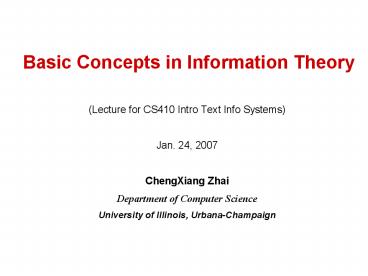Basic Concepts in Information Theory PowerPoint PPT Presentation
1 / 13
Title: Basic Concepts in Information Theory
1
Basic Concepts in Information Theory
- (Lecture for CS410 Intro Text Info Systems)
- Jan. 24, 2007
- ChengXiang Zhai
- Department of Computer Science
- University of Illinois, Urbana-Champaign
2
Background on Information Theory
- Developed by Shannon in the 40s
- Maximizing the amount of information that can be
transmitted over an imperfect communication
channel - Data compression (entropy)
- Transmission rate (channel capacity)
3
Basic Concepts in Information Theory
- Entropy Measuring uncertainty of a random
variable - Kullback-Leibler divergence comparing two
distributions - Mutual Information measuring the correlation of
two random variables
4
Entropy Motivation
- Feature selection
- If we use only a few words to classify docs, what
kind of words should we use? - P(Topic computer1) vs p(Topic the1)
which is more random? - Text compression
- Some documents (less random) can be compressed
more than others (more random) - Can we quantify the compressibility?
- In general, given a random variable X following
distribution p(X), - How do we measure the randomness of X?
- How do we design optimal coding for X?
5
Entropy Definition
Entropy H(X) measures the uncertainty/randomness
of random variable X
Example
H(X)
P(Head)
1.0
6
Entropy Properties
- Minimum value of H(X) 0
- What kind of X has the minimum entropy?
- Maximum value of H(X) log M, where M is the
number of possible values for X - What kind of X has the maximum entropy?
- Related to coding
7
Interpretations of H(X)
- Measures the amount of information in X
- Think of each value of X as a message
- Think of X as a random experiment (20 questions)
- Minimum average number of bits to compress values
of X - The more random X is, the harder to compress
A fair coin has the maximum information, and is
hardest to compress A biased coin has some
information, and can be compressed to lt1 bit on
average A completely biased coin has no
information, and needs only 0 bit
8
Conditional Entropy
- The conditional entropy of a random variable Y
given another X, expresses how much extra
information one still needs to supply on average
to communicate Y given that the other party knows
X - H(Topic computer) vs. H(Topic the)?
9
Cross Entropy H(p,q)
What if we encode X with a code optimized for a
wrong distribution q? Expected of bits?
Intuitively, H(p,q) ? H(p), and mathematically,
10
Kullback-Leibler Divergence D(pq)
What if we encode X with a code optimized for a
wrong distribution q? How many bits would we
waste?
Properties - D(pq)?0 - D(pq)?D(qp) -
D(pq)0 iff pq
Relative entropy
KL-divergence is often used to measure the
distance between two distributions
- Interpretation
- Fix p, D(pq) and H(p,q) vary in the same way
- If p is an empirical distribution, minimize
D(pq) or H(p,q) is equivalent to maximizing
likelihood
11
Cross Entropy, KL-Div, and Likelihood
Likelihood
log Likelihood
Criterion for selecting a good model
Perplexity(p)
12
Mutual Information I(XY)
Comparing two distributions p(x,y) vs p(x)p(y)
Properties I(XY)?0 I(XY)I(YX) I(XY)0
iff X Y are independent
Interpretations - Measures how much
reduction in uncertainty of X given info. about
Y - Measures correlation between X and Y
- Related to the channel capacity in
information theory
Examples I(Topic computer)
vs. I(Topic the)?
I(computer, program) vs (computer,
baseball)?
13
What You Should Know
- Information theory concepts entropy, cross
entropy, relative entropy, conditional entropy,
KL-div., mutual information - Know their definitions, how to compute them
- Know how to interpret them
- Know their relationships

